From Zurich, our TGV—Train Grande Vitesse—is smooth and speedy, and by mid-afternoon we have arrived at the Gare de Lyon in
Paris. Soon we are standing on rue Chateau d’Eau, outside the courtyard of what
will be our home for three weeks. Three flights up the polished oak stairway
and we enter what was once probably an attic, then a servant’s room, now
an elegant artist-writer’s loft.
After ten days of pleasure-travel, I am eager to begin my research for two different book projects, both historicals. Here in Europe, you take in the history with every breath, every step. Our first steps take us to the nearby Canal St. Martin, a familiar and now very trendy quartier.
We have dinner at Fric-Frac, a casual-cool spot on the canal, then stroll back to our studio.
The weather has turned
stormy, making for an even more dramatic view.
The next day we head for the modern art museum,
Centre Pompidou and, like everyone, head first for the exterior escalator with
its world-beating view.
We’re here to catch the last day of a
major Anselm Kiefer retrospective. A German born just after WW2, Kiefer deals with the legacy of this conflict in large and powerful multimedia works of crematoria, burning fires, desolate landscapes.
I am surprised to learn that one of his great influences was Vincent Van Gogh, a subject of my research. In fact as a student, Kiefer followed the Van Gogh trail that we too are here to take.
We lunch at the rooftop
restaurant. Lovely, but $9 for a bottle of water? I have forgotten to order a
(free) carafe d’eau, available
everywhere.
Later I wander other floors,
recognizing the hand of Master Matisse.
A day later we are aboard another train for
Arles, where Van Gogh produced some of his most famous work—including my
favorite, Starry Night Over the Rhone.
We connect through the ancient Roman town of Nîmes,
where I pause before this plaque in memory of deported Jewish children.
Our train to Arles is late,
but we enjoy our time in the station’s café.
We ride the train with some sympathique locals who tell that these
yellow fields we have admired are rapeseed, canola oil.
We soon arrive in Arles, this
station rural and small. I like it already!
We walk along the Rhone to our
hotel, just inside the old city walls.
Hotel du Musée is a restored,
centuries-old villa with two lovely courtyards.
We are following Vincent’s
route in Arles, seeing the very spots where he painted some of his most famous
work. The city has erected plaques showing the painting in front of the actual
view.
I am also trying to visualize
the town as it was 100 years ago, streets my characters might have walked and
worked.
I visit the cemetery, another step back in time.
We reach the Yellow House,
which we later learn was bombed during WW2 and later rebuilt with different proportions.
Inside I meet the owner’s
daughter, who tells me her father will soon arrive with old documents of the
period to show me. The walls are hung with period photos and I am back in time.
We next go to the Square du
Forum, the setting for Van Gogh’s Café de Nuit. Ahead is the
Roman Coliseum.
We find the
hospital where Vincent was treated after cutting off his ear, but where is the courtyard scene?
Returning to the river, we
see our own Starry Night over the Rhone.
Down the lane from our hotel
is a Provençal resto built inside the old wall. Our pizza is brilliant, testifying to
this region’s Mediterranean roots.
It’s but a few steps back to
our hotel were we fall into bed.
After a peek at the quiet early morning street and rooftops, I leave my husband to his breakfast, content with my mission to sample a local croissant later.
I am off to find another
Van Gogh site, the Pont de Trinquetaille.
I head back inside the old
town and find the hospital entrance we were unable to locate last night. Here is
the courtyard view of La Maison de Santé.
Wandering inside the old
structure, I feel Vincent’s presence.
This carousel was built only
ten years after his death.
Who wouldn’t want mail delivered by this cheery postman?
I continue to a quiet canal and a bit beyond it, another Van Gogh site, Alyscamps, the old Roman burial ground.
I cross the railroad tracks in search of another scene, the old mill.
Maybe this is it. Maybe not.
Re-entering the old city walls, I reach the Coliseum where a plaque marks the
view point for Les Arenes d’Arles.
Struck by the blue and
yellows I’ve seen everywhere in my wanderings, I realize how much this
town influenced Vincent.
Like him, I have fallen in
love with Arles and pass through these cobbled lanes as if in a dream.
Returning to collect my
husband, I take him to the hospital courtyard garden for a crepes lunch.
Inside these old walls, I stumble upon a new and quirky library, similar in spirit to that
in Bologna.
Far far too soon, it is time
to check out of our lovely hotel.
(Why did I plan only a one-day trip?!) To make the most of every
moment, we walk back to the railway station along the Rhone, still searching
for the Starry Night view plaque. Near the Yellow House, we see the remnants of a
WW2 bombed bridge...
…the
seductively curving river…
but not the actual site where Vincent stood and painted the timeless image that makes me delirious with emotion.
but not the actual site where Vincent stood and painted the timeless image that makes me delirious with emotion.
Next time, I vow.
The quiet little train
station awaits us. I love this town.




















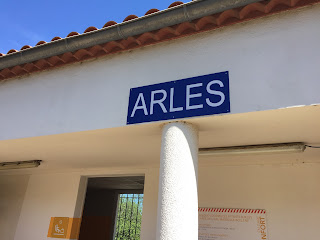
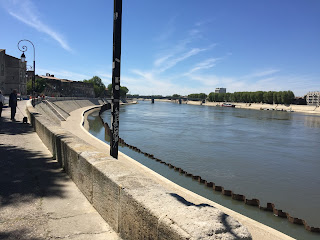

















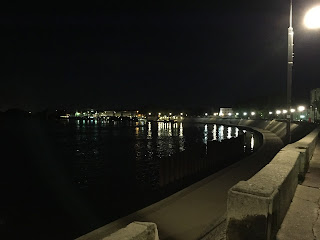




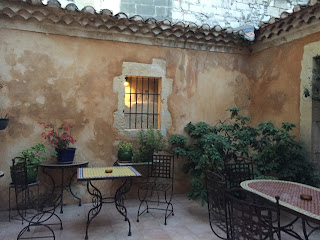






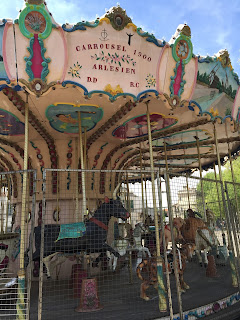

























No comments:
Post a Comment